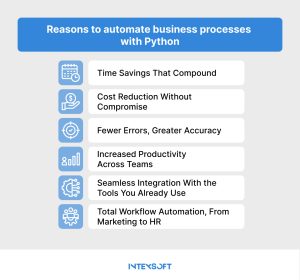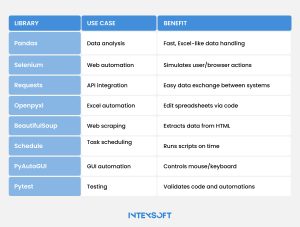Using Python for Automation: Transform Your Business and Save Hundreds of Hours

This article focuses on IT automation with Python. You will learn why this programming language performs exceptionally well in automation tasks. We also highlight the signs and red flags within your business processes that suggest it’s time to automate. Explore real-world use cases, essential libraries, and the top tools to consider. Need a free consultation? Contact our experts.
Reading time: 19 min.
Python has emerged as the stealth weapon of business automation. And it’s winning.
With more than 8 million developers globally, according to SlashData, Python is now one of the most popular languages in the world. And its popularity isn’t just about its simplicity. The language is as powerful as it was approachable, built on open-source principles that encouraged collaboration over gatekeeping.
And that vision stuck. Python’s high-level syntax — think clean, human-readable code that looks closer to English than machine gibberish — has made it accessible for both entry-level data analysts and veteran coders navigating complex enterprise systems.
So what makes Python a world’s secret weapon for automating business processes in 2025? Let’s break it down:
As we have mentioned above, Python is open-source, accessible, endlessly flexible, and quietly revolutionizing how companies—from startups to Fortune 500s—streamline everything from invoices to Instagram posts.
So, Why Automate with Python?

Routine, mind-numbing tasks—like updating spreadsheets, parsing emails, or generating reports—can be scripted to run on their own. That means fewer manual keystrokes and more time spent on strategic work. Think: managing your business, not being managed by it.
Outsourcing repetitive tasks to Python scripts is like hiring a team of robots who work 24/7, never call in sick, and don’t ask for healthcare. Whether it’s automating invoice processing or scheduling follow-up emails, Python slashes operational costs while keeping performance sharp.
Manual data entry is a minefield. One typo can send invoices to the wrong clients or tank a campaign. Python doesn’t fat-finger keys. Once programmed, it executes instructions with machine precision—meaning cleaner data, fewer mistakes, and less time spent on damage control.
With Python picking up the slack, your team is free to focus on what matters—solving problems, creating value, and innovating. Whether it’s automating lead follow-ups, syncing calendars, or generating performance dashboards, Python lets humans do what humans do best: think.
Python plays nice with nearly everything—Excel, Google Sheets, APIs, CRMs, Slack, Mailchimp, Zapier. Its rich ecosystem of libraries (like Pandas, Selenium, and Requests) means it can bridge systems that weren’t designed to talk. In short: Python glues your workflow together.
Python’s versatility shows up in unexpected places. Email drip campaigns? Automated. Social media scheduling? Done. Hiring pipelines? Filtered and organized with a single script. Billing, lead tracking, customer responses—it’s all within Python’s reach.
Python doesn’t care about your vertical. It doesn’t care what industry conference you went to last year. What it cares about is automating the grunt work so your team can focus on actual thinking.
From HR to finance to manufacturing floors, Python is stitching together APIs, scraping data, and running background jobs that never miss a deadline or forget to cc the right person.
Let’s break it down. These are the real-world use cases where Python is stealthily—and brilliantly—reprogramming modern business.
| Business Function | Automated Tasks with Python | Key Benefits |
| Data Analysis and Reporting | – Generate real-time dashboards – Automate weekly/monthly reports – Forecast sales and trends – Detect anomalies in datasets | Better visibility, faster insights, proactive decisions |
| CRM Automation | – Auto-fill lead data from forms – Trigger follow-up emails – Score and tag leads – Sync CRM with other tools | Improved lead management, faster response time |
| Inventory Management | – Track stock levels in real-time – Alert for low inventory – Forecast restocking needs – Automate reorders | Reduced stockouts, optimized warehouse operations |
| Marketing Workflow Automation | – Schedule social media posts – Trigger drip campaigns – Segment users and personalize messages – Analyze content performance | Increased engagement, consistent messaging |
| Accounting and Finance | – Auto-generate invoices – Parse receipts and expense reports – Reconcile accounts – Automate payroll | Fewer manual errors, time savings, compliance ease |
| Project Management | – Update tasks in tools (e.g., Jira, Trello) – Send reminders for deadlines – Generate project reports – Sync calendars | Streamlined workflow, reduced delays |
| HR Process Automation | – Parse resumes and shortlist candidates – Automate interview scheduling – Manage onboarding tasks – Track leave balances | Faster hiring, smoother employee onboarding |
| Industrial & Manufacturing | – Monitor equipment in real time – Predict maintenance needs – Automate quality control with AI – Sync ERP/MES systems | Reduced downtime, better production planning |
Let’s look at all the functions of Python programming for automation in more detail.
One battleground stands out in particular: data analysis.
Imagine a bot that wakes up at 6 AM, scrapes your e-commerce backend, cross-references yesterday’s customer behavior, identifies anomalies in your ad spend, and sends you a dynamic report before your stand-up call. That’s what Python has been doing for thousands of businesses.
It’s also democratizing insights. You don’t need a six-figure analytics stack when you’ve got a Python script tapping APIs and visualizing trends with a few lines of code. From real-time KPI dashboards to auto-generating investor-ready PDFs, Python is the unsung hero of intelligent reporting.
Let’s talk about the other power play: customers.
Python listens to new leads, fills in the blanks, tags contacts, schedules follow-ups, and even nudges your sales reps when a lead goes cold. It doesn’t forget birthdays, mislabel a high-value account, or ghost a hot prospect.
A potential client fills out your web form. Within seconds, Python parses the form, enriches the data via LinkedIn and other APIs, assigns a score based on behavior patterns, logs it into your CRM, and triggers a three-part email sequence. All without a human touch.
Python can monitor CRM health, analyze funnel efficiency, and surface insights sales managers would normally miss. Is your conversion rate tanking after the first call? Python will find it. Are follow-ups taking too long? Python will fix it.
And if your stack includes Salesforce, HubSpot, or any CRM worth its salt, there’s probably already a Python wrapper for its API. Meaning? No waiting for developers. No costly SaaS plugins. Just code that gets things done.
With libraries, Python scripts can track stock levels in real-time, flag anomalies, and forecast demand with uncanny accuracy. Integrate it with your POS or warehouse management system, and you get a dynamic inventory ecosystem.
Running an e-commerce store? Python can monitor your Shopify or WooCommerce backend, identify fast-moving SKUs, and trigger auto-reorders when stock hits a threshold. If you’re in manufacturing, it syncs with your ERP and schedules replenishments like clockwork.
Marketing loves creativity. But creativity without consistency is chaos. Scheduling posts, running drip campaigns, analyzing engagement—it’s all necessary, and it’s all complex when done manually. That’s why Python’s become the behind-the-scenes MVP of digital marketing.
With the right scripts, Python handles it all. Need to schedule posts across Twitter, Instagram, and LinkedIn? Python + APIs = done. Want to track open rates on your email campaigns and adjust subject lines based on A/B testing results? Python’s already on it. Tools like BeautifulSoup and Selenium can even scrape competitor ads and social posts, giving marketers fresh ammo daily.
It also works seamlessly with CRMs, CMSs, and ad platforms. Whether you’re optimizing a Facebook ad budget or curating personalized newsletters.
Invoices, expense reports, payroll runs—Python automates the boring and reduces human error by an order of magnitude. Think OCR-powered receipt parsing using Tesseract. Automatic reconciliation between bank statements and ledger entries. Real-time budget vs. actuals dashboards. All of it, automated.
It can sync with QuickBooks, Xero, or NetSuite through their APIs, pull financial data, run risk analyses, and even flag suspicious transactions based on rules you define. And when it’s tax season? Python scripts can organize documents, categorize expenses, and generate reports that your accountant will actually thank you for.
Forget the manual Gantt charts and the overdue task reminders. Python scripts can monitor Jira, Trello, or Asana boards, analyze bottlenecks, and shoot alerts before deadlines go sideways. Need to pull updates from team members and push status reports to Slack every morning? Python will do that without needing another stand-up.
Want to know which tasks are stalling the sprint? Python can scrape your entire backlog, detect stagnation patterns, and serve up analytics dashboards that your PMs actually want to look at.
Resume parsing? Python can extract skills, experience, and education from PDFs at scale. Shortlisting candidates? Python applies logic to screen against job criteria in real time. Interview scheduling, candidate follow-ups, offer letters—fully automated.
Onboarding? Python scripts can trigger IT account setups, send training modules, sync with HRIS tools like BambooHR or Workday, and even assign mentors based on department logic.
Python integrates with IoT sensors to monitor machinery health, predict maintenance needs, and reduce costly downtime. Using platforms like Raspberry Pi and microcontrollers, Python scripts can control production workflows, optimize output in real time, and dynamically adjust operations based on supply chain fluctuations.
Data logging, quality control checks, barcode scanning, machine calibration, predictive maintenance—Python is no longer a backend tool. It’s an operational command center running at machine speed.
Even traditional SCADA systems are getting retrofitted with Python extensions to modernize workflows.
It’s the libraries—open-source, battle-tested, community-fueled—that are doing the real heavy lifting.

Here’s your insider’s guide to the Python libraries driving the automation revolution:
This is real, boots-on-the-ground Python: auto-tagging leads at 3 a.m., reordering stock before it runs dry, parsing resumes in milliseconds, and spitting out CFO-ready dashboards with precision.
What used to require armies of interns, SaaS Frankenstein stacks, or six-figure dev retainers? Python replaces 100 lines of code. And it’s only getting better—thanks to open-source communities, AI integrations, and a plug-and-play ecosystem.
Automate now—or get automated later. Contact IntexSoft anytime.